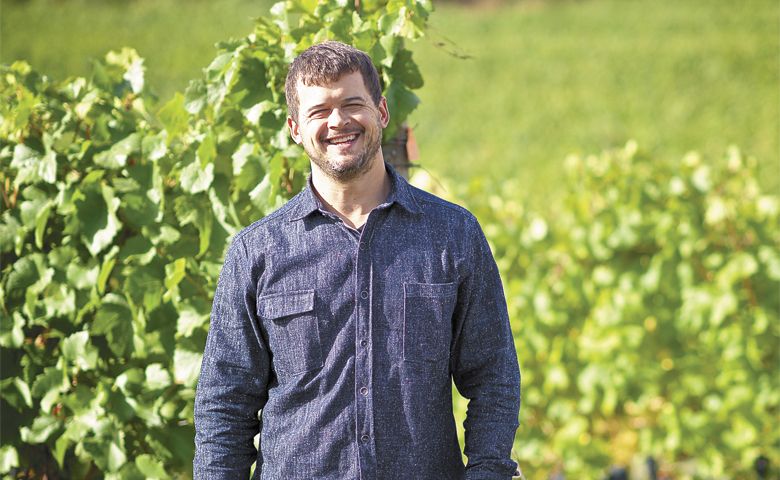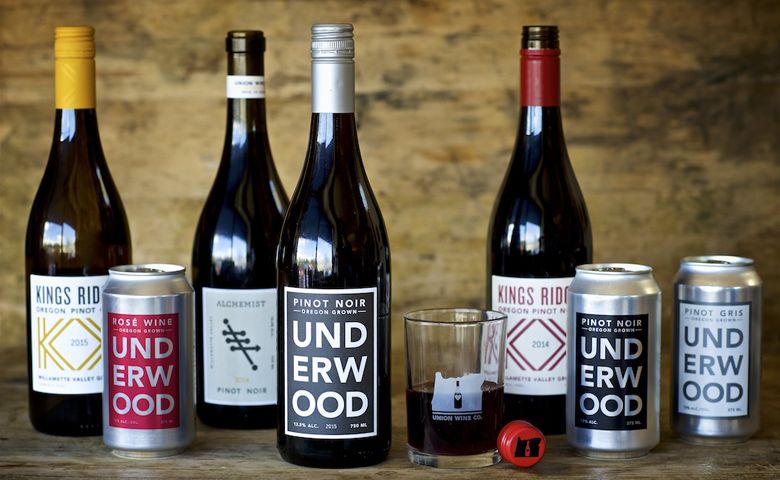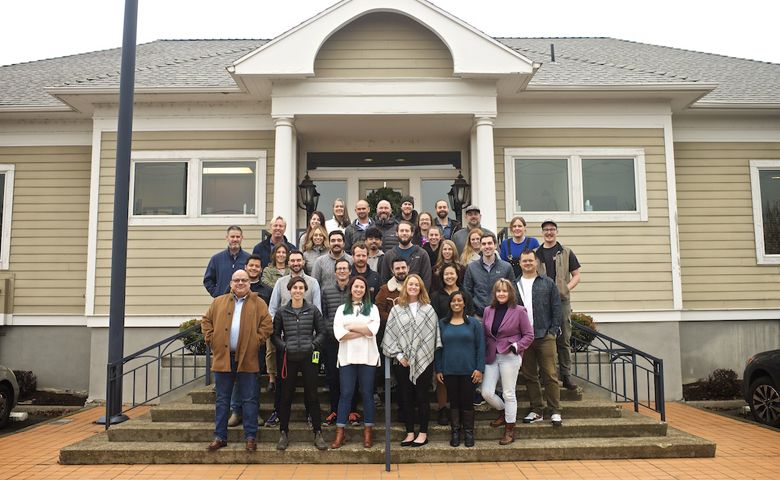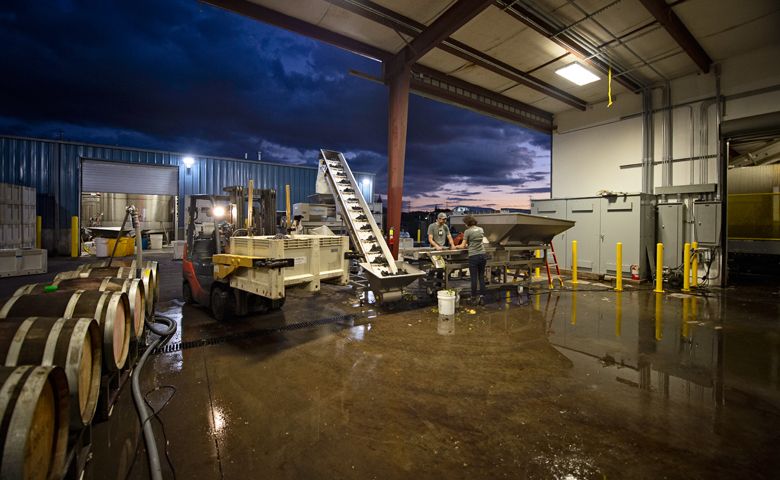Oregon Can Man: Ryan Harms
2019 OWP Person of the Year
In 2013, just days before a relatively normal harvest turned topsy-turvy thanks to an unlikely monsoon, a relatively new product was unveiled. At Feast, Portland’s largest food and beverage gathering, Ryan Harms debuted his canned Pinot Gris and Pinot Noir. Little did he know, he was sitting on the sharpest side of a spearheading trend with his newest venture in his Union Wine Company lineup.
“We anticipated that some people might find it interesting, but we really didn’t have any expectations that this was going to become a thing,” Harms says. “In the months following Feast, we had media, wine distributors and consumers enthusiastically pushing us to bring the cans to market, and never in my career have I been a part of something like that. It was a humbling experience.”
The rest, as they say, is history. Union Wine Company is now the state’s largest producer, operating out of a 43,000-square-foot canning facility in Tualatin. It technically launched in 2005 but began slowly, and the canned brand, Underwood, didn’t really flourish until several years later. The growth since has been grand if not exponential. In 2018, Union turned out approximately 380,000 cases. By the end of this year, the output will clock in at a cool 515,000 cases. The company is 39 employees strong and counting, and Harms continues to sit at command as both founder and president.
You can find the Underwood cans just about everywhere these days, from the shelves of New Seasons to professional sporting events. The cool factor, coupled with the portability and overall trending nature of the crushable genre, cannot be overstated. Aside from being incredibly accessible, the Underwood cans are eye-catching, and with unique partnerships with outside companies, some are practically collector’s items — the custom cans released for local pro soccer teams the Portland Timbers and Thorns, for example.
Always innovating, the Underwood line is increasingly known for collaborations and creative infusions as well. The winery worked with Los Angeles chef Mei Lin on its Mei Wine release, a tropical and refreshing cooler that mixes Riesling, lemongrass, guava, lychee, yuzu, tea and more. The Riesling Radler, a session-style blend of Riesling, hops and grapefruit, dons a label that could double as the wallpaper from your favorite tiki bar. The Strawberry Cooler, a mix of Pinot Noir, cranberry juice, local strawberries and lime, tastes like springtime in Oregon. And the latest release, a Nouveau Pinot Noir, capitalizes on the presently fashionable light and fresh style.
The larger umbrella company that is Union presides over two other non-canned labels as well: Alchemist and Kings Ridge. The former focuses on relatively higher-end Pinot Noir and Chardonnay, while the latter pushes sub-$20 bottlings of Pinot Noir, Riesling and Pinot Gris. The fruit is sourced from throughout the Willamette Valley, testament at least in part to just how connected Harms is with the Oregon scene. Prior to starting Union, he worked at recognizable outfits like REX HILL and Bergström.
Harms continues to receive compliments from many of his peers, a fairly remarkable feat given the Willamette Valley’s not always glowing embrace of larger-scale wine operations. As the wine industry worldwide aims to be more approachable, Underwood’s angle is textbook and tantalizing. It’s an inviting brand, for certain — just look at the simple, vertically stacked letters of the boxy label — but perhaps, most importantly, it’s a vast and visible one. If a consumer is going to run into an Oregon wine in a supermarket in some faraway state, the chances are good that it will be a Union product. The company has a fleet of managers covering all the major regions of the U.S.
Pinot Noir continues to be Oregon wine’s calling card, but that’s changing, too. “I have been concerned for some time that Oregon’s wine business is strongly tied to one varietal and believe that has the potential to be an issue if consumers’ tastes and preferences change,” Harms says. “That being said, I like the growth I am seeing in Chardonnay from Oregon. Rosé from here continues to be healthy and fizzy, bubbly and sparkling wines from Oregon are growing nicely off of a small base. These are all really positive trends in the market, and I think Oregon wines are well positioned to continue to deliver on these national trends.”
The popularity of canned wine continues to provide fuel and inspiration. For the record, Union’s current facility turns wine out at the rate of 600 to 650 cans per minute — equivalent to 200 to 250 bottles. It’s strikingly fast and one of the most efficient wineries in the country. Doing everything in house and at high speed has allowed Union to triple its output. “By keeping our production overhead costs down, we are able to maintain affordable prices for consumers while expanding our portfolio.”
This is also the social media era, in which hashtags like #pinkiesdown become larger-than-life slogans and brand mantras. Union’s work is Instagram gold, as a few clicks online will reveal. It’s stylish and on-the-go. The company’s social media feed reflects as much, packed with active young imbibers, happy to have something they can take with them on a hike or a stroll through the park. This is not your stuffy tasting room with novel-like tasting notes written in cursive. This is the fun-loving, unpretentious wine world more and more people, millennials especially, are calling home.
“Putting wine into a vessel that is common to many consumers makes people feel more comfortable with drinking wine,” he continues. “You can’t easily sniff or swirl wine in a can. It forces you to just drink it and enjoy it without overthinking the activity. I hope the lack of pretense that is embodied in a can helps consumers, who previously haven’t felt comfortable with purchasing or consuming wine, to try it.”
So far, the approach is not just working but thriving. The company finds itself deliberately at the forefront of a surging canned wine movement. In 2018, sales grew about 70 percent. Canned wine remains a thin slice of the overall American wine production pie, which Underwood and a growing number of producers are working to change. By now, most Oregon producers of a certain size have at least entertained the idea of offering an aluminum-clad offshoot; some have fully followed Underwood’s lead.
Other forces are at play within the movement, like cost and sustainability. Harms says canned wine costs about 40% less to package compared to the same amount of wine going to glass. For a wine that won’t be cellared and therefor shouldn’t change much, if at all, the can is even more attractive. Additionally, aluminum is lightweight, recyclable and lower-input from an energy standpoint when compared to most traditional glass bottle plants.
Simply keeping pace with demand has been one of Union’s biggest challenges. There are only so many vineyards out there and when your growth is substantial, lining up fruit contracts and maintaining quality can be tricky. Being able to ferment, package and release wines from a single spot in the northern Willamette Valley has certainly helped Union’s cause.
The ability to pivot with the market is of equal importance. Union has done a lot of that since the beginning, whether it’s been a response to renewed consumer love for rosé or sparkling, or mixing together an unexpected wine-based concoction altogether. The company could have just as easily created a formula for two major varietals and stuck it out with some respectable growth. Instead, Harms has paid attention to developing subplots and tweaked Union’s own products accordingly.
“Feedback has been extremely positive,” Harms continues. “Our consumers appreciate that we put the same quality wine in both bottles and cans, and that the cans are simply alternative packaging.”
Harms thinks there’s room for more growth in the canned sector. “I hope to see some more luxury offerings come out in cans,” he says. “I think there are consumers for that tier, and I look forward to seeing how that part of the category and industry develops.”
Harms has helped popularize local canned wine to unforeseen heights. His labels have drawn in throngs, appealing even to those who’d never considered wine. And his project has grown to one of the largest in the Northwest, without a noticeable decline in quality or the burned bridges that so often accompany such ascension.
For these reasons and more, he’s has been named Oregon Wine Press’ Person of the Year in 2019.














